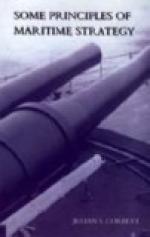Examples.—Diversion.—Our raid on Washington in 1815. Landing force, about 4,000 men. Object, according to official instruction, “a diversion on the coasts of United States of America in favour of the army employed in the defence of Canada”; i.e., the intention was negative—preventive—defensive. Eccentric Attack.—Operations against New Orleans in 1815. Intended force, 15,000 to 20,000 men. Object, “to obtain command of the embouchure of the Mississippi, and, secondly, to occupy some important and valuable possession, by the restoration of which the conditions of peace might be improved, &c.”; i.e., the intention was positive—to acquire. Compare Rochefort Expedition (diversion) with those against Martinique and Belleisle (eccentric attacks) in the Seven Years’ War.
This distinction gives a threefold classification of combined expeditions, as used by Elizabethan strategists, viz., raids, incursions, and invasions. These correspond respectively with our modern diversions, eccentric attacks, and true direct offensive.
LIMITED AND UNLIMITED WARS
From the nature of the ulterior object we get an important classification of wars, according to whether such object is limited or unlimited.
(1) War with limited object ("limited war”) is where the object is merely to take from the enemy some particular part of his possessions or interests; e.g., Spanish-American War, where the object was the liberation of Cuba.
(2) War with an unlimited
object is where the object is to overthrow
the enemy completely, so that
to save himself from destruction he must
agree to do our will (become
subservient); e.g., Franco-German War.
PLANS OF WAR
System of Operations
Having determined the nature of the war by the nature of its object (i.e., whether it is offensive or defensive and whether it is limited or unlimited), Strategy has to decide on the system of operations or “plan of the war.”
Apart from the means at our disposal a plan of war depends mainly upon—
(1) The theatre of the war.
(2) The various theatres of operation
available within it.
1. Theatre of the War.—Usually defined as “All the territory upon which the hostile parties may assail each other.” This is insufficient. For an Island Power the theatre of war will always include sea areas. Truer definition: “Geographical areas within which must lie the operations necessary for the attainment of the ulterior objects of the war and of the subordinate objects that lead up to them.”
A “theatre of war” may contain several “theatres of operations.”
2. Theatre of Operations.—Is generally used of the operations of one belligerent only.




